| کد مقاله | کد نشریه | سال انتشار | مقاله انگلیسی | نسخه تمام متن |
|---|---|---|---|---|
| 8847068 | 1617857 | 2017 | 27 صفحه PDF | دانلود رایگان |
عنوان انگلیسی مقاله ISI
Ecomorphological structure of avian communities changes upon arrival of wintering species
ترجمه فارسی عنوان
ساختار اکوورفولوژیک جوامع مرغی پس از ورود گونه های زمستانی تغییر می کند
دانلود مقاله + سفارش ترجمه
دانلود مقاله ISI انگلیسی
رایگان برای ایرانیان
کلمات کلیدی
ترجمه چکیده
ترکیب جامعه نشان دهنده فرآیندهای تکاملی و زیست محیطی مانند تنوع و تنوع گونه است. جوامع به طور کلی در نظر گرفته می شود که اشباع شده اند، به این معنی که تعداد گونه ها به حداکثر می رسد و سازوکارهای نظارتی مانند رقابت های متقاطع، از اضافه کردن گونه های جدید جلوگیری می کند. اما در مناطق گرمسیری، تعداد گونه گونه های محلی پرنده در هر زمستان پس از ورود گونه های مهاجر، دو برابر شده است، که نشان می دهد که بازسازی نیش ها رخ می دهد. در اینجا فضای اکولوژیکی به واسطه ویژگی های مورفولوژیکی که موقعیت زیست محیطی گونه ها را نشان می دهد، برای توصیف تغییرات در ساختار جوامع محلی تعریف شده است. ما دریافتیم که میانگین فاصله مورفولوژیکی بین گونه ها کاهش می یابد و حجم (کل وسعت فضای صفت) با ورود مهاجران گسترش می یابد و نشان می دهد که تازه واردین در حاشیه و درون فضای محیط زیست در دسترس قرار می گیرند. علاوه بر این، با بیشتر تفاوت های مورفولوژیکی بین گونه های ساکن، تعداد بیشتری از گونه های مهاجر می توانند از فضای آزاد استفاده کنند و به دلیل مورفولوژی بینابینی از منابع استفاده نشده بهره ببرند. ما تفاوت ها را در ویژگی های گونه های مهاجران ساکن در نظر می گیریم که ممکن است هر دو را در فضای مورفولوژیکی قرار دهد و ما نظریه همزیستی را به عنوان یک توضیح احتمالی برای همزیستی گونه های مشابه پیشنهاد می کنیم.
موضوعات مرتبط
علوم زیستی و بیوفناوری
علوم کشاورزی و بیولوژیک
علوم دامی و جانورشناسی
چکیده انگلیسی
Community composition reflects evolutionary and ecological processes such as diversification and species assortment. Communities are generally considered to be saturated, which means that the number of species is maximized and that regulatory mechanisms, such as interspecific competition, prevent the addition of new species. In the tropics, however, species numbers of local bird assemblages double up each winter after the arrival of migratory species, which suggests that a rearrangement of niches occurs. Here ecological space is defined by morphological traits that reflect the ecological position of species, to describe changes in the structure of local communities. We found that the average morphological distance between species was reduced, and the volume (the total extent of trait space) was expanded with the arrival of migrants, indicating that newcomers occupy the periphery and the interior of the available ecological space. Furthermore, with greater morphological differences between resident species, higher numbers of migratory species can take advantage of free space and potentially exploit unused resources due to their intermediate morphology. We highlight the differences in the attributes of resident versus migratory species that may allow both to be accommodated in the morphological space, and we suggest coexistence theory as a possible explanation for the co-occurrence of similar species.
ناشر
Database: Elsevier - ScienceDirect (ساینس دایرکت)
Journal: Basic and Applied Ecology - Volume 24, November 2017, Pages 60-67
Journal: Basic and Applied Ecology - Volume 24, November 2017, Pages 60-67
نویسندگان
Andreia Malpica, Sara Covarrubias, Rafael Villegas-Patraca, Leonel Herrera-Alsina,
